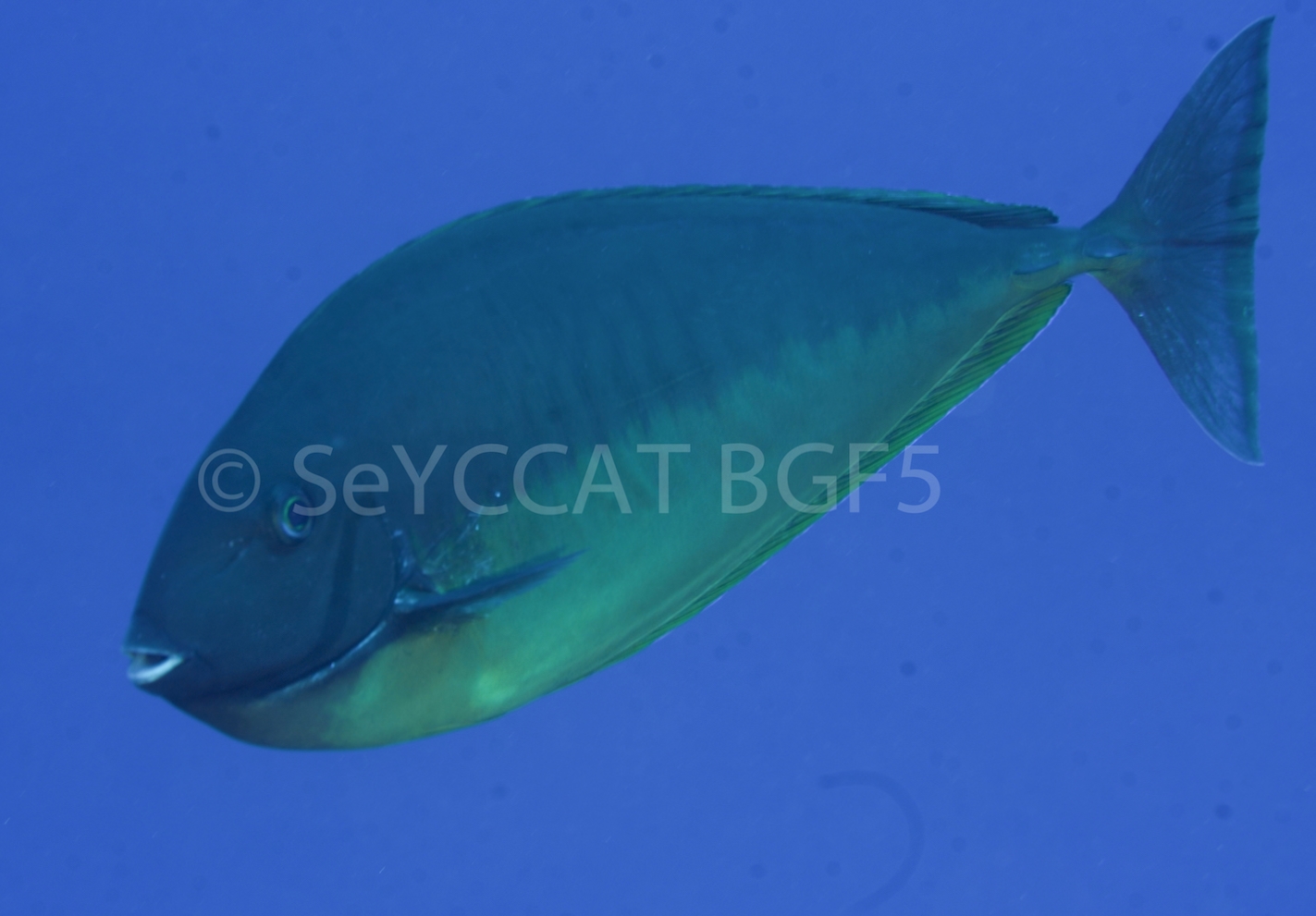Description:
Dorsal spines: 6 (5-7); Dorsal rays: 26-29; Anal spines: 2; Anal rays: 27-30.
Medium to large sized unicornfish. Body moderately deep and compressed. Dorsal profile of head sloping and smoothly convex without horn-like protuberance. Interorbital space
strongly convex with a slight median ridge. Mouth small with numerous, very small incisiform teeth. Dorsal profile of body uniformly convex. Dorsal fin continuous and unnotched.
Caudal peduncle slender, subcylindrical, two large peduncular plates, the keels with a forward projecting point in adults. Caudal keels in males are enlarged. Caudal fin
emarginate in young, truncate in adults.
Colour. Brownish to bluish grey dorsolaterally changing to yellowish grey ventrally, the demarcation along middle of side often abrupt and irregular. Edge of the opercle
and preopercle usually dark brown. Margin of lower lip white. Upper surface of tongue of adults black. Dorsal and anal fins yellowish with faint diagonal brown bands and a
blue margin. Caudal fin blue with a broad brownish yellow posterior border that narrows toward corners of fin. Capable of rapidly changing to light greyish blue overall, such
as when at cleaning stations. Males in courtship quickly display a broad bluish white zone on nape and anterior upper part of body, followed by narrow bars of the same colour
that extend onto lower side.
Size:
Maturity: Lm 45.0 cm SL, range unknown. Max length: 75.0 cm FL; Common length: 50.0 cm TL.
Habitat and Ecology:
Inhabits clear lagoon and seaward reef slopes (depth 6-150 m, usually 10-140 m). Benthopelagic. Often seen in large aggregations. Feeds on the larger animals of the
zooplankton such as crab larvae, arrow worms, pelagic tunicates and occasionally filamentous red algae. Juveniles are more common on midshelf reefs and feed on macroscopic and
turf algae and strongly associated with reef substrata. It is herbivorous up to age 2 years. Males have characteristic mating colours when courting in open water. Typically
spawn in pairs, however, this species has been observed to form spawning aggregations on the Great Barrier Reef.
Fishery Status:
This species is not protected or subject to fishery regulations. It is unclear to what extent it forms part of the artisanal catch.
Notes:
Photo courtesy Eleanor Brighton and Chris Mason-Parker (c) 2022 Blue Safari Seychelles/Marine Conservation Society, Seychelles. Photograph taken at Alphonse group 2022.
References:
Bray, D.J. (2022). Naso hexacanthus in Fishes of Australia, https://fishesofaustralia.net.au/home/species/2196 (14/07/22).
Choat, J.H. et al. (2012). Naso hexacanthus. The IUCN Red List 2012: https://dx.doi.org/10.2305/IUCN.UK.2012.RLTS.T178002A1517273.en. (14/07/22).
Froese, R. & D. Pauly. (Eds.) (2022). FishBase. https://www.fishbase.in/summary/Naso-hexacanthus.html (14/07/22).
Randall, J.E. (2001). Surgeonfishes of Hawaii and the World. ISBN: 1-56647-561-9
Citation:
Nevill, J.E.G., Brighton, E. & Mason-Parker, C. (2022). Naso hexacanthus, Sleek unicornfish. Seychelles Seatizens. www.seatizens.sc. https://seatizens.sc/species/naso-hexacanthus-bleeker-1855/


There are no comments